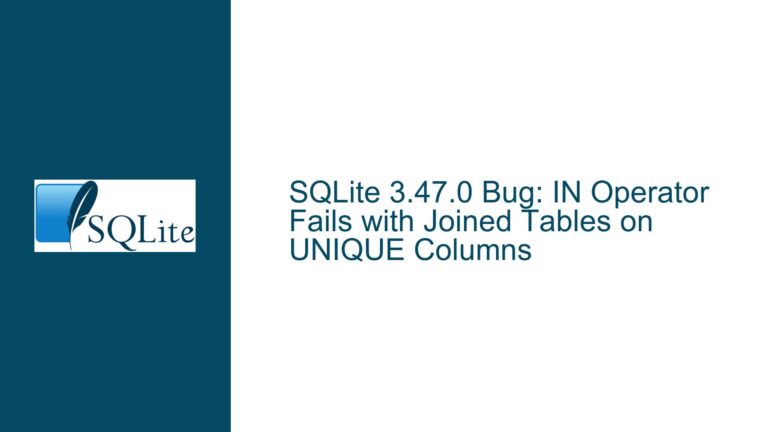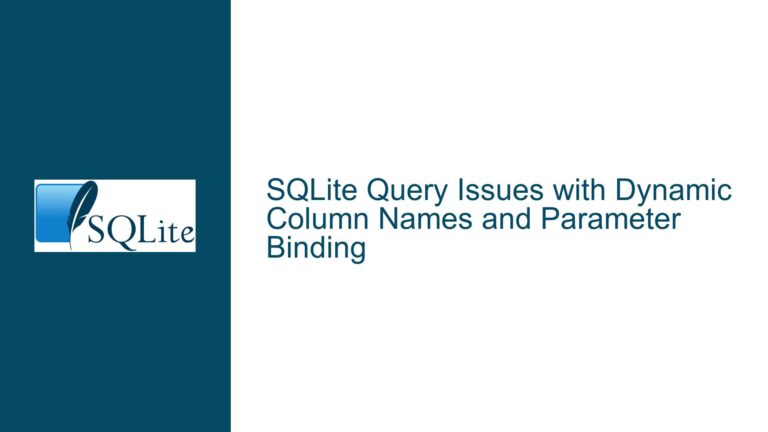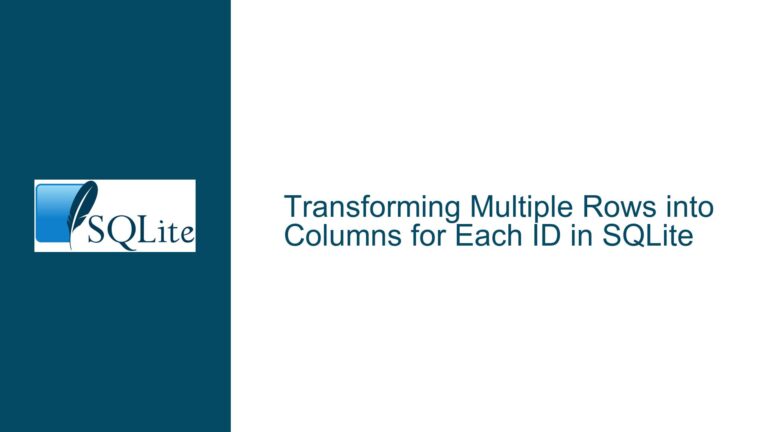Using ORDER BY with JSON_GROUP_ARRAY in SQLite: Documentation and Troubleshooting Guide
Issue Overview: JSON_GROUP_ARRAY and ORDER BY Syntax in SQLite
The core issue revolves around the use of the ORDER BY clause within the JSON_GROUP_ARRAY function in SQLite. This functionality allows developers to aggregate values into a JSON array while specifying the order of the elements within that array. The confusion arises from the lack of explicit documentation in the JSON functions section of the SQLite documentation, leading users to question whether a subquery is still necessary to achieve ordered aggregation.
The JSON_GROUP_ARRAY function is an aggregate function that collects values from a column or expression and returns them as a JSON array. Historically, if developers wanted to ensure the elements in the resulting JSON array were ordered, they had to use a subquery to first sort the data and then apply the aggregation. However, starting with SQLite version 3.44.0 (released on November 1, 2023), SQLite introduced the ability to include an ORDER BY clause directly within the JSON_GROUP_ARRAY function. This enhancement simplifies queries by eliminating the need for subqueries in many cases.
Despite this improvement, the documentation for this feature is not prominently featured in the JSON functions section of the SQLite documentation. Instead, it is mentioned in the section on built-in aggregate functions, which can lead to confusion for developers who are specifically looking for JSON-related functionality. This oversight in documentation placement has caused some users to miss this feature entirely or to question its existence.
The syntax for using ORDER BY within JSON_GROUP_ARRAY is straightforward:
SELECT json_group_array(ColumnName ORDER BY ColumnName) FROM table;
This query aggregates the values from ColumnName into a JSON array, ordered by ColumnName. The ORDER BY clause is embedded directly within the aggregate function, making the query more concise and easier to read.
However, the introduction of this feature raises questions about its impact on query performance and execution plans. Developers have observed that the query plans for queries using this new syntax differ from those using traditional subqueries for ordering. This has led to concerns about whether the new syntax introduces additional overhead or if it is simply a more efficient way to achieve the same result.
Possible Causes: Why the Confusion Exists
The confusion surrounding the use of ORDER BY within JSON_GROUP_ARRAY stems from several factors, including documentation placement, version compatibility, and the evolution of SQLite’s functionality.
Documentation Placement: The primary source of confusion is the placement of the documentation for this feature. While the JSON_GROUP_ARRAY function is a JSON-related function, the documentation for using ORDER BY within it is located in the section on built-in aggregate functions. This separation can make it difficult for developers to find the information they need, especially if they are specifically searching for JSON-related functionality. The JSON functions section (Section 4.22) does not explicitly mention this feature, leading users to believe that it might not exist or that they need to use subqueries for ordering.
Version Compatibility: Another factor contributing to the confusion is version compatibility. The ability to use ORDER BY within JSON_GROUP_ARRAY was introduced in SQLite version 3.44.0, which was released on November 1, 2023. Many operating system distributions and environments still use older versions of SQLite, which do not support this feature. Developers working in these environments may attempt to use the new syntax and encounter errors or unexpected behavior, leading them to believe that the feature is not supported or that they are using it incorrectly.
Evolution of SQLite Functionality: SQLite has evolved significantly over the years, with new features and enhancements being added regularly. While these improvements are generally well-documented, the rapid pace of development can make it challenging for developers to keep up with the latest changes. The introduction of the ORDER BY clause within aggregate functions like JSON_GROUP_ARRAY is a relatively recent development, and some developers may not be aware of it, especially if they are accustomed to using older versions of SQLite or relying on outdated documentation.
Query Plan Differences: The observation that query plans differ when using the new syntax has also contributed to the confusion. Developers who are familiar with the traditional approach of using subqueries for ordering may be concerned that the new syntax introduces additional overhead or changes the way SQLite processes the query. This concern is compounded by the lack of detailed documentation on how the new syntax affects query performance and execution plans.
Troubleshooting Steps, Solutions & Fixes: Addressing the Confusion and Ensuring Proper Usage
To address the confusion surrounding the use of ORDER BY within JSON_GROUP_ARRAY and ensure that developers can use this feature effectively, the following troubleshooting steps, solutions, and fixes are recommended.
1. Verify SQLite Version: The first step in troubleshooting this issue is to verify the version of SQLite being used. The ability to use ORDER BY within JSON_GROUP_ARRAY is only available in SQLite version 3.44.0 and later. To check the version of SQLite, run the following query:
SELECT sqlite_version();
If the version is older than 3.44.0, the feature will not be available, and developers will need to either upgrade SQLite or use the traditional approach of using a subquery for ordering.
2. Upgrade SQLite: If the version of SQLite is older than 3.44.0, the next step is to upgrade to a version that supports the new syntax. Upgrading SQLite can be done by downloading the latest version from the official SQLite website and following the installation instructions for the specific operating system or environment. It is important to ensure that all applications and services that rely on SQLite are compatible with the new version before proceeding with the upgrade.
3. Use the Correct Syntax: Once the correct version of SQLite is in place, developers can use the new syntax for ORDER BY within JSON_GROUP_ARRAY. The correct syntax is as follows:
SELECT json_group_array(ColumnName ORDER BY ColumnName) FROM table;
This syntax aggregates the values from ColumnName into a JSON array, ordered by ColumnName. It is important to note that the ORDER BY clause is embedded directly within the aggregate function, and there is no need for a subquery.
4. Compare Query Plans: Developers who are concerned about the impact of the new syntax on query performance can compare the query plans for queries using the new syntax with those using the traditional approach. To view the query plan, use the EXPLAIN QUERY PLAN statement:
EXPLAIN QUERY PLAN SELECT json_group_array(ColumnName ORDER BY ColumnName) FROM table;
Compare this with the query plan for the traditional approach:
EXPLAIN QUERY PLAN SELECT json_group_array(ColumnName) FROM (SELECT ColumnName FROM table ORDER BY ColumnName);
While the query plans may differ, the new syntax is generally more efficient because it eliminates the need for a subquery. However, the actual performance impact will depend on the specific query and dataset, so it is important to test and compare the results in the context of the application.
5. Update Documentation Awareness: To avoid confusion in the future, developers should be aware of the documentation placement for this feature. While the JSON_GROUP_ARRAY function is documented in the JSON functions section, the ability to use ORDER BY within it is documented in the section on built-in aggregate functions. Developers should consult both sections when working with JSON-related functionality in SQLite.
6. Provide Feedback to the SQLite Team: If developers find the documentation placement confusing or believe that additional clarification is needed, they can provide feedback to the SQLite team. The SQLite team is responsive to user feedback and may consider updating the documentation to make the feature more discoverable.
7. Use Subqueries as a Fallback: In environments where upgrading SQLite is not feasible, developers can continue to use the traditional approach of using subqueries for ordering. The following syntax can be used as a fallback:
SELECT json_group_array(ColumnName) FROM (SELECT ColumnName FROM table ORDER BY ColumnName);
This approach ensures that the data is ordered before aggregation, even in older versions of SQLite that do not support the new syntax.
8. Monitor Performance: Regardless of the approach used, developers should monitor the performance of their queries to ensure that they are not introducing unnecessary overhead. This is especially important when working with large datasets or complex queries. Tools such as SQLite’s built-in query planner and third-party performance monitoring tools can be used to identify and address performance bottlenecks.
9. Educate the Team: Finally, developers should educate their teams about the new syntax and its benefits. By sharing knowledge and best practices, teams can ensure that everyone is using the most efficient and up-to-date techniques for working with SQLite. This can help prevent confusion and ensure that all team members are aware of the latest features and enhancements.
In conclusion, the ability to use ORDER BY within JSON_GROUP_ARRAY is a powerful feature that simplifies queries and improves readability. However, the confusion surrounding its documentation placement and version compatibility can lead to challenges for developers. By following the troubleshooting steps and solutions outlined above, developers can ensure that they are using this feature effectively and avoiding common pitfalls.






